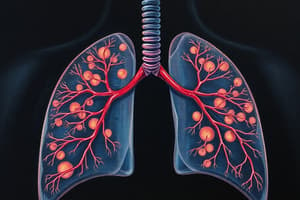Podcast
Questions and Answers
Which of the following is NOT a main function of the respiratory system?
Which of the following is NOT a main function of the respiratory system?
- Gas exchange (O2 and CO2)
- pH Regulation
- Defense from pulmonary pathogens
- Nutrient absorption (correct)
During aerobic respiration, the body consumes CO2 and produces O2.
During aerobic respiration, the body consumes CO2 and produces O2.
False (B)
What is the primary function of ventilation in the context of respiration?
What is the primary function of ventilation in the context of respiration?
To cause airflow in and out of the lungs.
The chemical reaction/colour change that occurs in the ______ involves the reoxygenation of blood.
The chemical reaction/colour change that occurs in the ______ involves the reoxygenation of blood.
Match the following pleural conditions with their descriptions:
Match the following pleural conditions with their descriptions:
What happens to alveolar pressure during inspiration?
What happens to alveolar pressure during inspiration?
The lungs possess their own muscles to inflate and deflate.
The lungs possess their own muscles to inflate and deflate.
How does an increase in PaCO2 affect ventilation?
How does an increase in PaCO2 affect ventilation?
In the context of gas exchange, gases move from areas of ______ pressure to areas of ______ pressure.
In the context of gas exchange, gases move from areas of ______ pressure to areas of ______ pressure.
What does pulse oximetry measure?
What does pulse oximetry measure?
When acidity increases, the affinity of haemoglobin for O2 increases, promoting O2 release.
When acidity increases, the affinity of haemoglobin for O2 increases, promoting O2 release.
What is the role of carbonic anhydrase in CO2 transport?
What is the role of carbonic anhydrase in CO2 transport?
In the equation for respiration controlling blood pH; CO2 and H2O can promote ______ conditions.
In the equation for respiration controlling blood pH; CO2 and H2O can promote ______ conditions.
What condition is described by tissues receiving inadequate O2 to support aerobic respiration?
What condition is described by tissues receiving inadequate O2 to support aerobic respiration?
During exercise, O2 use typically decreases compared to the resting state.
During exercise, O2 use typically decreases compared to the resting state.
In what part of the brainstem are central chemoreceptors located?
In what part of the brainstem are central chemoreceptors located?
The ______ pressure refers to the force exerted by air within the alveoli of the lungs and changes during the process known as ventilation.
The ______ pressure refers to the force exerted by air within the alveoli of the lungs and changes during the process known as ventilation.
According to the respiratory quotient, when organisms are primarily using carbohydrates as a fuel source, what is the approximate ratio of CO2 produced to O2 consumed?
According to the respiratory quotient, when organisms are primarily using carbohydrates as a fuel source, what is the approximate ratio of CO2 produced to O2 consumed?
The main function of myoglobin is to transport oxygen throughout the bloodstream to various tissues.
The main function of myoglobin is to transport oxygen throughout the bloodstream to various tissues.
Match each lung volume measurement to its correct description.
Match each lung volume measurement to its correct description.
Flashcards
Main functions of the respiratory system?
Main functions of the respiratory system?
Gas exchange between O2 and CO2, pH regulation to maintain enzyme function, defence from pathogens, vocalisation, and sense of smell.
Ventilation
Ventilation
Causes closed airways during breathing.
Alveoli
Alveoli
Chemical reaction and colour change in lungs; oxygenate & supply/colour: essential diagnosis!
Pleural Membrane
Pleural Membrane
Signup and view all the flashcards
Pneumothorax
Pneumothorax
Signup and view all the flashcards
Arterial Blood Gases (ABG)
Arterial Blood Gases (ABG)
Signup and view all the flashcards
Chemoreceptors
Chemoreceptors
Signup and view all the flashcards
Respiratory Quotient (RQ)
Respiratory Quotient (RQ)
Signup and view all the flashcards
Bohr effect
Bohr effect
Signup and view all the flashcards
Pulmonary arteries
Pulmonary arteries
Signup and view all the flashcards
Ventilation
Ventilation
Signup and view all the flashcards
Intrapleural pressure
Intrapleural pressure
Signup and view all the flashcards
Study Notes
Five Main Functions of the Respiratory System
- Gas exchange (O2 and CO2) is a primary function; inability to perform this leads to blood pH change, resulting in respiratory acidosis
- pH regulation is achieved through CO2 accumulation; lower pH, and the enzyme requires pH 7.4 for proper function, becoming dysfunctional in an acidic environment
- Defence against pulmonary pathogens is a key role; stage 2 involves asthma, COPD, and cystic fibrosis, while stage 4 involves advanced lung cancer
- Vocalisation occurs as air passes through the larynx
- Facilitating the sense of smell occurs through sniffing
Metabolism and Respiration
- Metabolism consumes O2 and produces CO2, requiring oxygen for aerobic respiration
- The body requires a constant oxygen supply for metabolic reactions, generating ATP, and the breakdown and conversion of molecules
- CO2 waste products are generated and expelled through breathing
- Respiration involves providing O2 and removing CO2, a process managed by the respiratory system
- Aerobic respiration involves consuming sugar and breathing in O2 to breathe out CO2
Stages of Respiration
- Ventilation (breathing) involves causing the lungs to move; actual mechanical breathing
- Pulmonary gas exchange includes inflating and deflating to exchange gas
- Transport of O2 and CO2 occurs via blood into tissues
- Systemic gas exchange sees tissues exchanging O2 and CO2
- Cellular respiration is the final stage
- Disorders like Hb issues or heart problems can disrupt gas exchange
Anatomy of the Respiratory System
- The upper respiratory tract includes the nose, nasal cavity, pharynx (throat), and larynx (voice box); the epiglottis prevents food from entering the lungs
- The lower respiratory tract facilitates breathing mechanics, including the trachea (windpipe), lungs, bronchi, alveoli (site of chemical reaction and reoxygenation), and the diaphragm muscle
- Alveoli are tiny air sacs where oxygen is supplied and colour changes indicate oxygen levels diagnosed clinically, aided by iron n oxygen chemical reaction
Protection and Structure
- Rib bones protect the lungs, allowing expansion and contraction
- Pleural membrane facilitates lubrication via a thin mesothelial layer with a double membrane (visceral against lungs, parietal against surrounding tissues)
- Pleural cavity contains pleural fluid for lubrication; fluid removal can occur
Pleural Conditions
- Pneumothorax is air in the pleural cavity and is pneumatic
- Pleural effusion involves fluid accumulation
- Haemothorax is blood in the cavity and potentially serious
Gas Laws and Ventilation
- Ventilation is the mechanical flow of air in and out of the lungs
- Boyle's Law means that as pressure increases, volume decreases
- Charles's Law means that temperature increases as volume increases
- Dalton's Law means that all component gases make up total pressure
- Lungs change internal pressure while breathing
- Alveolar pressure increases during inspiration and decreases during expiration
- Intrapleural pressure, within the pleural cavity, is responsive to the diaphragm
Diaphragm and Pressure
- The diaphragm is a dome-shaped muscle that separates the thoracic and abdominal cavities and is the primary muscle used in inspiration
- Nervous system controls the process where diaphragm contraction helps expansion of thoracic cavity and lungs
- Increased cavity volume leads to decreased intrathoracic pressure
Respiratory Control
- The lungs lack muscles for inflation/deflation
- The respiratory muscles and diaphragm control pressure
- Respiratory centres control the rate of contraction
Control Centres and Receptors
- At rest, body cells utilize 200 mL of O2 per minute, increasing 15-20 fold during exercise
- The respiratory system maintains CO2 and O2 levels, responding to bodily fluids such as exercise, illness, and drug therapy
- Chemoreceptors respond to CO2, H+, and O2 levels, providing input to the respiratory centre
- Ventilation increases with PaCO2 rise, and ventilation decreases with PaCO2 fall via respiratory control centres
Gas Exchange
- The respiratory quotient (RQ) is the ratio of carbon dioxide production to oxygen consumption, reflecting fat, carbohydrate, and protein in the diet
- High PO2 is found in the lungs in alveoli and high PCO2 in blood
- Arterial Blood Gases (ABG) enable measurement of blood exchange
- CO2 is the main waste product from respiration
Haemoglobin and Oxygen Transport
- Hemoglobin protein carries oxygen in red blood cells
- Fetal haemoglobin has a higher affinity for O2, absorbing more oxygen
- Muscle transports O2 using myoglobin, which has a higher oxygen affinity than haemoglobin and stores/releases oxygen in muscles
- High temperature and increased acidity (pH decreases) reduce haemoglobin's affinity for O2
Forms of Transport
- Waste CO2 is transported in three forms; as dissolved CO2 (7% in blood plasma), bound to haemoglobin (23%), and as bicarbonate ions (70% in blood plasma)
- A key equation governs respiration-controlled blood pH through carbonic anhydrase
- Hypoxia describes inadequate oxygen support in tissue, causing impaired oxygenation and impaired blood supply
Studying That Suits You
Use AI to generate personalized quizzes and flashcards to suit your learning preferences.





